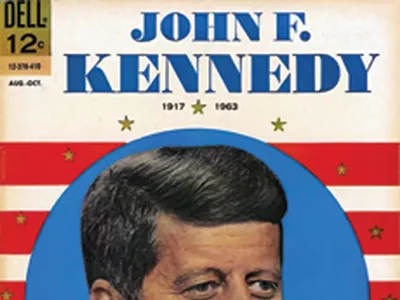Given a seemingly ravenous appetite in recent years for images fetishizing Detroit’s decline, ruin porn continues to be one of the city’s biggest cultural exports. Photos of hulking, decayed symbols such as Michigan Central Station and the Packard Plant are so well-circulated that, at this point, it’s a wonder the well hasn’t dried up. By the time of a recent airing of Anthony Bourdain: Parts Unknown — the Detroit-themed episode where the titular world-traveler and chef discusses Detroiters’ disdain for ruin porn while at the same time seemingly shooting some of his own — you could almost hear the collective audience groan: Ugh, this story? Again?
Can it be that ruin porn fatigue is finally starting to set in? Might there be an appetite out there for images of Detroit when it was still one of the most prosperous cities in the country?
Detroit 1968, a new book of photographs by Enrico Natali and released by Foggy Notion Books, is decidedly not ruin porn. On the surface, the collection shows a middle-class utopia whose residents are enjoying the American Dream. Children play in the streets. Teen girls practice gymnastics and go shopping downtown. Workers proudly pose while taking a break from their blue-collar jobs in factories and warehouses, and businessmen smoke cigarettes in their offices.
Certainly, the year in Detroit 1968 makes it a loaded title, one that usually evokes the myth that Detroit’s decline started with the ’67 riots, and the book is not the post-riots journal you might expect from the name alone.
The foreword addresses this myth head-on: the conditions for decline — the automobile and accompanying infrastructure, which led to a steady migration of city-dwellers to the suburbs and a shrinking tax base — had actually already been in effect for decades.
His new publisher liked the title Detroit 1968, Natali admits by phone from his home in California: in reality he shot the images from 1967 to ’70. The collection was originally published in 1972 with the more upbeat title, New American People.
“The [original] publisher felt that these people weren’t specific to Detroit and represented people all over the country,” he says. At the time, Detroit was enjoying its last gasps as one of the nation’s urban powerhouses.
The stark black-and-white images in Detroit 1968 are as representative of that decade in America as any. Fans of shows like the period piece Mad Men will appreciate Natali’s stylish subjects, from office workers with gravity-defying bouffants to hippies in groovy attire. Natali’s gift for capturing slightly mysterious, immediate compositions lends further appeal to the images here.
At the time, Natali’s photographs may have seemed idyllic, but the vantage of hindsight makes the contemporary viewer aware that what is depicted was not built to last. You don’t have to look hard to see the hints. Though Natali portrays both white and black people with the same amount of empathy — and enjoying the same amount of relative prosperity — the people in his photographs are as segregated in the pages of the book as they were in real life.
Natali says befriending organizer Frank Ditto after the riot (depicted as a burly man in African garb on one of the pages) is what allowed him access to the black community. There’s a sequence of pages that shows alternating, similarly posed living room portraits of white and black families. Another photo shows a barely teenaged boy wearing a beret, fists crossed over his chest — a member of Ditto’s Community Patrol Corps, a youth-led vigilante police force meant to meet the needs that Detroit’s then-mostly-white police force failed to address. Only one photo in the book addresses the riots at all, not showing the fires or the violence, but instead a group of soldiers escorting black children down a street.
There are other references to the more tumultuous aspects of the ’60s, as well. One image shows a couple wearing flower garlands at a love-in demonstration, another shows people holding signs protesting the Vietnam War.
For Natali, it wasn’t a matter of documenting the times so much as letting the times speak to him. “I don’t consider myself as a documentary photographer at all,” says Natali, who originally came to Detroit in 1966 to work as chief photographer for department store giant Hudson’s. Previously, Natali had his eureka moment with a body of work he shot in New York, capturing people on the subway.
“That was when I realized photography was my vocation,” Natali says. “One night I was looking at those pictures and I realized, wow, this was bigger than I am. The conditions of the subway were like a gift because there were these constraints on the environment, on the way people stood, on the background. When I saw what was there, I realized it was my job to photograph different parts of America.”
After he had been in Detroit for about a year, he got the idea to shoot a series. “I always thought in terms of a book, or at least a large collection of pictures,” he says. “I never thought of them as individual pictures.”
Natali has since moved away from photography, opening a Zen meditation center with his wife in Ojai, Calif. But to him, photography is not all that different from meditation: both are about letting yourself go.
“I was like a photographer monk,” he says of the three years devoted to shooting for the book. “I put these constraints on myself: I’m going to only photograph people. I’m going to try to photograph as broad a cross-section as I can. I’m going to use only one focal length, one kind of film, one developer, one size print.”
The result is a coherent body of work that captures ground zero of one of the most pivotal decades in American history and a city still at the apex of its power. “I put all these constraints on myself, and that allowed the photography to fade into the background so I could just go into situations and work on automatic pilot,” Natali says. “At some point that situation starts guiding you. You get a message that’s bigger than you are.”
Check out a slideshow gallery of photos from the book here.
A book release party for Detroit 1968 will take place at 7 p.m. Friday, Nov. 22, at the Museum of Contemporary Art Detroit, 4454 Woodward Ave., Detroit; 313-832-6622. Enrico Natali will be present for a Q&A and reception, which is free and open to the public.







